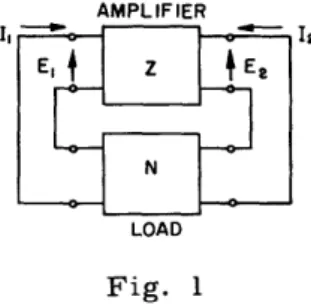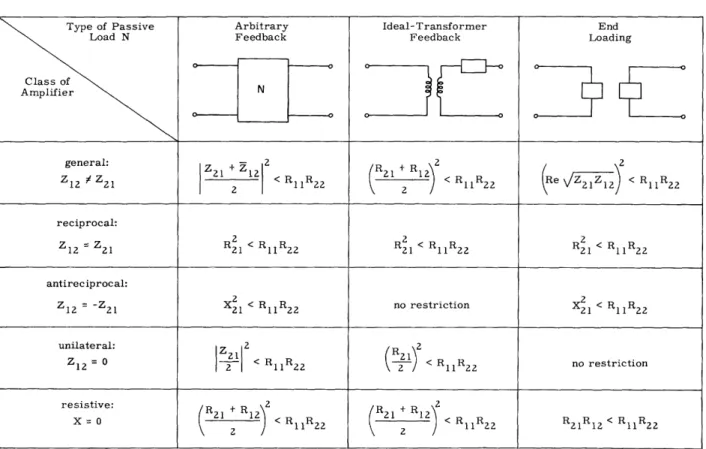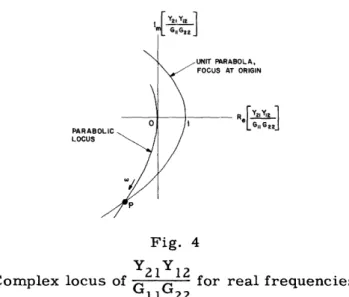Dooun.t;
J.t
A OCUNT ROOI 36-412
EUas
achus e 4is T S i-fCilAD 1 L:,'CRITERIA FOR DOCILE BEHAVIOR OF FEEDBACK AMPLIFIERS
SAMUEL J. MASON
43
I
TECHNICAL REPORT 258
JUNE 10, 1954
RESEARCH LABORATORY OF ELECTRONICS
MASSACHUSETTS INSTITUTE OF TECHNOLOGY CAMBRIDGE, MASSACHUSETTS
The Research Laboratory of Electronics is an interdepart-mental laboratory of the Department of Electrical Engineering and the Department of Physics.
The research reported in this document was made possible in part by support extended the Massachusetts Institute of Tech-nology, Research Laboratory of Electronics, jointly by the Army Signal Corps, the Navy Department (Office of Naval Research), and the Air Force (Office of Scientific Research, Air Research and Development Command), under Signal Corps Contract DA36-039 sc-42607, Project 132B; Department of the Army Project 3-99-12-022.
MASSACHUSETTS INSTITUTE OF TECHNOLOGY RESEARCH LABORATORY OF ELECTRONICS
Technical Report 258 June 10, 1954
CRITERIA FOR DOCILE BEHAVIOR OF FEEDBACK AMPLIFIERS
Samuel J. Mason
Abstract
A docile amplifier is one that remains stable when connected to an arbitrary passive network of a specified type. Docility criteria are developed for end-loading, for ideal-transformer feedback, and for an arbitrary passive feedback network.
INTRODUCTION
In the design of amplifier circuits to be used in conjunction with passive loading or coupling networks, the question of docility arises. A docile amplifier is defined here as one that remains stable when connected to any passive network of a specified type. Figure 1 shows the amplifier Z and the attached passive two-port (two-terminal-pair) network N. The amplifier is represented as a two-port linear active device with open-circuit impedances Z1 1 Z12, Z21, Z2 2. Network N loads each end of the amplifier
and may also provide external feedback.
The amplifying system is presumably driven by an independent signal source but the drive may be ignored in a stability analysis. We shall need only the equations of the amplifier
E 1 = ZlI1 + Z1ZI2 (1)
E2 = Z2 1I1 + Z22I2 (2)
These may be recast as the matrix equation
(E2= 12
)(
'l1 (3)E2 Z21Z22/ 12
or, in more abbreviated form,
E = ZI - (4)
The net complex power delivered to the amplifier is very conveniently expressed as the matrix product
Et (E 1E2) = E1I + E2I (5)
where the subscript t denotes transposition. Docility can be assured by requiring that the real power shall be positive, and this requirement leads to conditions upon Z. We shall first state the conditions and then present proofs.
1I
Fig. 1
The loaded amplifier.
DOCILITY CRITERIA
Table I shows the three types of passive loading considered here: arbitrary feed-back, ideal-transformer feedfeed-back, and end loading. For a given load type, the amplifier is docile if and only if:
(a) The amplifier is open-circuit stable, that is, Zll, Z1 2, Z2 1, and Z2 2 have no
poles in (or touching) the right half of the complex-frequency plane.
(b) The open-circuit input and output resistances, R1 1 and RZZ, are positive at all
real frequencies.
(c) The inequality shown in Table I is satisfied at all real frequencies.
Moreover, if the amplifier is not docile for a given load type, instability can always be produced by a lossless network of that type.
Conditions (a) and (b) are obvious. Taken together, (a) and (b) insure the positiveness of R11 and R2 2 in the right half plane, also necessary for stability under passive loading.
The same is true of the inequality (c). Conditions (a) and (c), taken together, imply the satisfaction of the inequality in the right half plane. It remains to justify the table.
Table I
Docility Criteria for Three Load Types.
-2-Type of Passive Arbitrary Ideal-Transformer End
Load N Feedback Feedback Loading
Class of Amplifier N general: 2 2 Z21 + 12 1 + R1 Z1 2 Z2 1Z1 Z 1Z 2<R 1 R2212 2 < R1 1R2 2 (R (. ZRz- ZZ~-~i Z 1ZI < R 2R2 reciprocal: 2 2 2 < R Z12 =Z2 1 21 < 1 1 2 2 R < 1 2 R <R11R22 antireciprocal: Z12 =21 X21 < RllR22 no restriction X21 < R22 unilateral: 2 Z12=0 2 <RR22 2 <RllRR 22 no restriction resistive: + R 2 R + X = y 21 12 < 1 1H 22 21 2 12 ) < 1 1 2 2 R2 1R12 < R 1 1R "
ARBITRARY FEEDBACK
The real power delivered to the amplifier is
P = Re [Et] = (Et+ It ) (6)
From Eq. 4 we find
Et =ItZt (7)
so that
- (Zt+
-1 (itzt + ItZJ) = t (8)
In order for currents I and I2 to exist in the undriven system, the power delivered to the amplifier must equal the power supplied by the feedback network. Since a passive network cannot supply power for complex frequencies in or touching the right half plane, the system can be made unstable if and only if P is negative somewhere in that fre-quency domain. Moreover, the feedback network can certainly be chosen to give any desired magnitude ratio and phase difference between I1 and I2. Hence matrix I is
com-pletely arbitrary. The docility condition, therefore, is that P must be positive at all real frequencies. (Open-circuit stability of Z then assures positiveness in the right half plane. ) The square matrix appearing in Eq. 8 is
Z21 21 + Z121
Rll
~R
2Z12 + Zal
The determinant and principal minors are real. In order for P to be positive for all I, this matrix must be positive definite, that is
Rll > 0, R2 2 > 0 (10)
- 2
RIIR2 212 2 > (11)
This completes the proof for arbitrary feedback. The result, though different in form, is identical with Tellegen's general passivity condition. (See Bibliography. )
IDEAL-TRANSFORMER FEEDBACK
The transformer feedback network shown in Table I differs from arbitrary feedback in that the quotient of I and I2 must be real. Hence the current matrix may be written
as a real matrix I multiplied by an exponential phase shift exp(je), and Eq. 8 becomes
P
= I t I (12)
where I is real. For transformer feedback, therefore, Eq. 11 is replaced by
R1 1RZ 2 (Z21 12 >0 (13)
END LOADING
To investigate end loading, we shall attach a passive impedance Z2 to the amplifier
output and then examine the resulting input impedance Z1 appearing at the opposite port.
From Eqs. 1 and 2
E Z 12Z21 Z1 I 1 Zll-
22
2 (14) where E2 Z2 = i (15) 2 It follows that Z2 2 +Z 2 (Z 1 2Z2 1)l/2 =Z Z11 j (16)(Z
12Z
2 1)l/2
Z
-or, in normalized form,
1 + 2 3iX22) (12Z
R22 R1 R22
(17)
( R 1 (Rzz) R1)
Equation 17 may be interpreted geometrically as the inversion shown in Fig. 2. Point p is inverted about point r to obtain point q. As p moves up the R2 = 0 line, q describes a clockwise circle, as shown. The conformality of the inversion makes the circle tangent to a vertical line when angle a reaches zero. At this point Eq. 17 is real, and the dimensions indicated in the figure follow directly. It is tacitly assumed that R11
and R are positive at real frequencies.
For stability under arbitrary passive end-loading we must have R1 positive. Hence
the necessary and sufficient condition for docile behavior is
-4-Fig. 2
The input-impedance diagram.
II -;
E - i;
z
TC~
i 2 Ir2 c|9mEg 'E2
Fig. 3
A two-port linear vacuum-tube circuit.
BOLA,
ORIGIN
[R 'YYI 1
L G1G2 2J
Fig. 4 Complex locus of Y21 Y12
G1 122for real frequencies.
-5-_ _ ___I _ _I_ _ _ __i I L I_ _ I _ _
J 1
-RR [Re(Z 2Z2 1l/2] > 0 (18)
at all real frequencies.
AN ILLUSTRATIVE EXAMPLE
Since the linear vacuum-tube model shown in Fig. 3 is short-circuit stable, it will be convenient to analyze it on the admittance basis. Suppose that we want to find the lowest possible frequency of oscillation under passive end-loading. The admittance matrix is
I + M~(C1 + Co) -jC
Y = (19)
m 0_ r2 j(C2 + Co)/
The dual form of the criterion given in Table I is, after a slight rearrangement,
1/2
Re 2 12 ) <1 (20)
It is easy to demonstrate that the inequality is satisfied at those real frequencies for which the complex locus of the quantity Y2 1Y1 2/G1 1G2 2 remains on the concave side of
the unit parabola shown in Fig. 4. To plot the locus we evaluate
Y21 Y12
G 2 Z= - JCo (gm- jCo) r 1 r2 (21)
and recognize the real and imaginary parts as the coordinates of a parabola, whose focal length
1 2
f = gm rr 2 (22)
happens to be equal to the low-frequency matched power gain of the amplifier. The parabolas intersect at point p where the frequency reaches the value
= [f(f_ 1)]-1/2 (23)
For a power gain f considerably larger than unity (the usual case), relation 23 may be rewritten as the power-gain docile-bandwidth product
gm
f o 2C (24)
o
The critical value oo is the lowest real frequency at which the amplifier will oscillate
-6-under passive end-loading.
For a chosen load the oscillations may start at a complex frequency whose imagi-nary part is less than w0. As the amplitude grows, however, the nonlinear behavior of the actual vacuum tube will bring about a reduction in the effective value of gm, and the oscillations will therefore settle at a real frequency greater than Wo, since a smaller
gm means a smaller focal length f. Such a gross simplification of the nonlinear effects is legitimate when the equilibrium amplitude of oscillations is not too large and when the steady-state waveform is nearly sinusoidal - in short, when the system is quasi-linear.
For completely docile behavior, of course, the focal length of the locus must be less than unity.
1 2
4 gm rr < 1 (25)
Incidentally, the docility requirement is the same for arbitrary feedback loading in this particular problem.
GENERAL DISCUSSION
For reciprocal amplifiers the criteria of all three load types reduce to the classical Gewertz condition. Hence, a docile reciprocal amplifier has all the properties of a passive two-port network, insofar as measurements at the available ports can show. Moreover, if the criterion is violated, any one of the three load types can be adjusted to cause instability.
The antireciprocal (or gyratory) amplifier is always stable under transformer feed-back, provided conditions (a) and (b) above are met. Its transfer reactance is restricted
in the same manner by both end-loading and arbitrary feedback loading. Hence a gyrator having purely resistive transfer impedances is universally docile.
A unilateral amplifier meeting conditions (a) and (b) is always docile for passive end-loading. With arbitrary feedback applied, the docility condition is recognizable as a requirement that the available power gain must not exceed unity. Otherwise a suitable feedback matching network could be chosen to make the system a feedback oscillator.
For the general amplifier, the end-loading criterion imposes a restriction upon the product Z1 2Z2 1. With transformer feedback or arbitrary feedback, however, we see
that the restriction is upon the sum of two transfer quantities. Under end-loading, docility is assured if either of the two transfer impedances can be made sufficiently small, since the internal feedback loop runs forward through Z2 1 and returns via Z12
to close upon itself. With external feedback, however, either Z1 2 or Z21 can produce
appreciable loop transmission. Hence it is not surprising that each must be restricted even when the other vanishes.
It is apparent that the docility criterion for arbitrary feedback is a severe restriction and that an amplifier satisfying such a requirement is indeed a very docile animal and not really a power amplifier at all. For this load type the criterion becomes useful in
the design of feedback oscillators, since we may wish to calculate the nondocile real-frequency range over which a tuned feedback network can produce oscillations.
The criterion for end-loading is of great interest in the analysis of cascaded ampli-fiers. An amplifier docile under end-loading is a respectable and dependable device. Passively loaded at one end, it presents a passive impedance at its opposite end. Hence a cascade of such devices is itself docile for loading at the two extreme terminations. The design may violate the criterion in a chosen band of real frequencies, provided the terminations are controlled in this region with a sufficient margin of safety. If the device satisfies the criterion outside this band, we can be assured of stability no matter how the passive terminating or interstage impedances behave at extra-band frequencies.
Most grounded-base and grounded-emitter junction transistors, incidentally, fail to meet the end-loading docility requirement in a midband of real frequencies, although they are both open-circuit stable and short-circuit stable and docile at both high and low frequencies.
Acknowledgment
The author is grateful to Dr. R. B. Adler for helpful discussions.
Bibliography
F. B. Llewellyn, Some fundamental properties of transmission systems, Proc. I. R. E. 40, 271-283 (1952).
B. D. H. Tellegen, The synthesis of passive, resistanceless four-poles that may violate the reciprocity relation, Philips Res. Rep. 3, 321-337 (1948).


